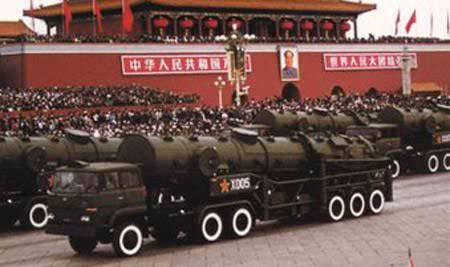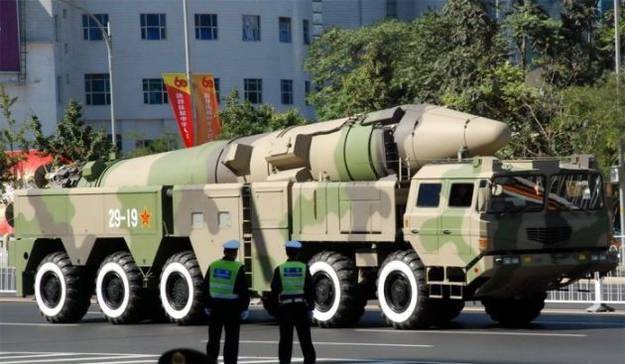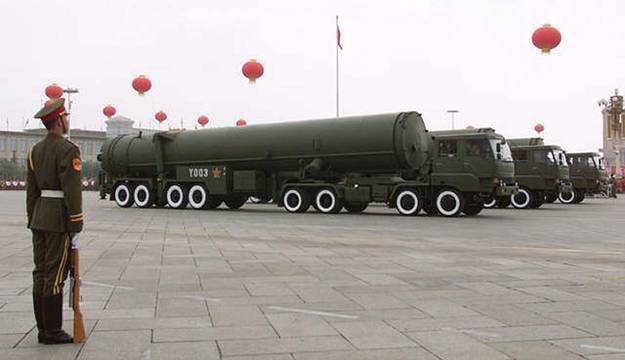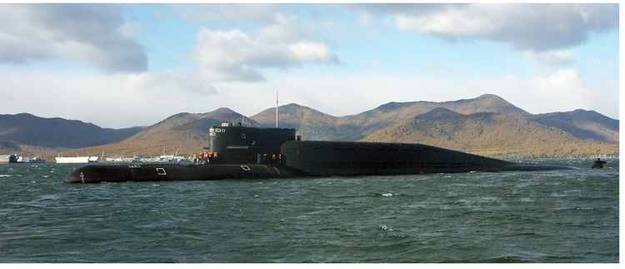How are China's strategic nuclear forces

After China last year successfully tested a solid-fuel mobile intercontinental ballistic missile with a split head that could “reach” to any point of the United States, the world said that now Beijing has a powerful means of nuclear deterrence and the Americans will have to rely with the new status of the Asian dragon. However, if you discard the propaganda husk and analyze the real state of affairs in the Chinese strategic nuclear forces, a completely different picture opens up - the PRC simply “eats” the remnants of the Soviet technologies kindly provided in the 50-60 of the 20th century, and also sold by Russian specialists in the era of 90 chaos . The USSR built in China whole industries — rocket production and nuclear fusion — with hundreds of factories and research centers, trained tens of thousands of Chinese specialists, and transferred all the technological documentation to all of its projects. Despite such a fantastic gift, for 60 years of existence of large-scale nuclear missile programs and multibillion-dollar investments, Beijing has not acquired a nuclear triad, or at least a sufficient arsenal of effective means of delivering warheads to the target. The reality is that in a true nuclear war, against America, China will not stand an hour.

Modern Chinese military industry was born in the 1950s with the help of the USSR. We have created a contemporary military-industrial complex capable of producing the entire range of military products needed by the National Liberation Army of China (PLA). The numbers are impressive: the Soviet Union in China built 763 full-fledged factories with all the infrastructure and the most modern equipment, 97 scientific and technological centers, 11 test sites, including 4 underground ones. More than 120 thousand Chinese students studied at Soviet technical universities on military subjects for free, and about 6 thousand Russian scientists, 85 thousand technologists, and other technical specialists visited China on long business trips. Then built enterprises, for example, aviation complexes in Shenyang, Harbin, Xi'an and Chengdu, tank factory in Baotou (Inner Mongolia, the so-called factory No. 617), a complex of enterprises for the production of small arms and artillery weapons in the northeast of the country and many others are still the basis of the Chinese military industrial complex.
The USSR transferred to the People's Republic of China licenses for the production of a full range of weapons and military equipment - from aircraft to communications and engineering equipment. The strategic armament did not stand aside either: before the Soviet-Chinese gap, China managed to get a huge array of documentation and equipment necessary to create the full production cycle of nuclear weapons. Moscow also took care of the development of Chinese rocket production, providing Beijing with samples of the P-1 and P-2 missiles and their manufacturing technology. P-2, by the way, is the first Chinese medium-range ballistic missile - the famous "DF-2", which at one time greatly frightened Japan.
In 1951, a secret agreement was signed between the USSR and the PRC on providing scientific and technical assistance to the Chinese in the field of nuclear research in exchange for their supply of uranium ore, under which the Union transferred uranium enrichment technologies, construction of centrifuges and other stages of the production process to China. By the way, the centrifuges themselves of the latest generation of Soviet production were eventually brought from Moscow and given away along with all the necessary documentation, because the Chinese experts could not master their production at the Soviet factories in their homeland. The Chinese general in charge of the nuclear project, Hun Zi, in a letter to Lawrence Beria wrote: “The process of mastering the production of gas centrifuges does not work. I ask you again to send a team of specialists to Hayon to debug equipment and train our engineers. Unfortunately, it will be necessary to shift the start-up date of the 651 plant into commercial operation for the fifth time. I hope, this time, technologists will still be able to fully convey all the details of the technology ... "
The same happened with the development of the production of missiles. For 6 years, Chinese specialists could not even produce a prototype using the X-31 project submitted by the Union. As a result, in the 1957 year, the USSR concluded another agreement on the transfer of the Celestial Empire of Soviet rocket technologies with the full cycle of training local specialists by the forces of Soviet universities. As part of this agreement, the Beijing Institute of Physics and Atomic Energy was established, where nuclear research began, and in Lanzhou - the construction of a gas diffusion plant to enrich uranium. The turning point for the Chinese was the start-up at plant No. 601 in the capital of the People's Republic of China of an experimental heavy-water nuclear reactor supplied by the Soviet Union with a thermal power of 7 megawatts and a cyclotron. In honor of this event, a holiday was declared in the country, and a just-born daughter of the PLA commander was named after the cyclotron. In 1958, under the guise of the strictest secrecy, the Soviet government opened a nuclear test site near Lake Lobnor in the Xinjiang Uygur Autonomous Region, where Chinese strategic forces are still conducting all of their tests.

After the P-2 short-range Soviet missiles were deployed on duty, China received the P-11 medium-range tactical ballistic missiles that were already equipped with nuclear warheads in the Soviet Union. As a result, the specialists of the USSR Ministry of Medium Machine Building at the Soviet factories, P-2, were launched into serial production under the name “Dunfen-1”, or “type 1059” (“Dongfen” - “East Wind”). The training squad with the Soviet P-2, formed in 1957, became the first compound of the new kind of troops, and the combat missile division, loudly called strategic, appeared in 1960. By the year 1961, the People’s Liberation Army of China already had 20 regiments equipped with Dunfeng-1 and P-11 (Chinese designation “1060 type”). In addition, the Celestial Empire acquired the production technology of jet bombers - front-line IL-28 (in China “Hun-5”) and long-range Tu-16 (“Hun-6”), which in the USSR performed the tasks of carriers
nuclear bombs. Earlier, the Soviet Union sent a large number of IL-28 and 25 heavy piston bombers Tu-4 to the PRC.
When Khrushchev came to power, Moscow fell out with Beijing and ceased to provide such a large-scale patronage of its southeastern neighbor that it immediately affected the course of China’s entire nuclear program. The launch of the Il-28 and Tu-16 strategic bombers was only possible in 1967 and 1968 respectively, and every second copy of the aircraft refused to take off.
While the USSR has already begun mass production of mobile missile kits with an active system for setting false targets and missiles with a range of up to 15 thousand km., October 27 1966, 12-kiloton uranium warhead delivered the first Chinese strategic ballistic missile Dunfeng at a range of 894 km -2 ”, developed on the basis of the Soviet Р-5М sample 1956 of the year. Joy at the government of China was full of pants: the Chinese defense industry for the first time managed to create a full-fledged nuclear missiles. On this occasion, special commemorative coins and chocolates were issued.
17 June 1967 from the board of the experienced long-range bomber “Hun-6” (Tu-16) - assembled from the Soviet nodes in 1959-m, was dropped the first Chinese hydrogen bomb. A two-phase charge based on uranium-235, uranium-238, lithium-6 and deuterium exploded at a height of 2960 m, showing the power of 3,3 megatons. A combat hydrogen charge with the megaton trotyl equivalent of 3, in which the Chinese first used plutonium (to initiate thermonuclear fusion), was tested as a 27 December 1968 tactical bombs by dropping the Hong-5 (IL-28) bomber. In the combat units of the PLA Air Force, “atomic” bombers came in the form of “Hun-XNUMHA” and “Hun-XNUMHA”. Then a more sophisticated “Qiang-5” appeared, which was developed on the basis of the Soviet MiG-6 fighter, mass-produced in the People's Republic of China under the Soviet license (J-5).
Since then, the qualitatively nuclear missile forces of the PRC have practically not changed. Vasily Kashin, a senior researcher at the Institute of Far Eastern Studies of the Russian Academy of Sciences, described their condition in the following way: “Until now, China’s strategic nuclear forces consisted of rather primitive and bulky intercontinental ballistic missiles. In addition, they launched the Dongfeng 31 and Dongfeng 31 A mobile solid-fuel missiles, which had range limitations and could carry only one warhead, which reduced their value and their ability to overcome the American missile defense system. The largest and most heavy Dongfeng 5 rocket is capable of striking most of the territory of the United States, but it is a huge and very vulnerable liquid rocket, preparing to launch takes at least 2 hours. There is one more missile, this is not quite the intercontinental Dongfeng 4, but after upgrading its range exceeded 5, 5 thousands of kilometers. However, it does not reach the continental part of the United States and is even more primitive. She can't even be based in the mine, she starts from the starting table. ”

These "Dongfeng 4" there are only ten pieces. There is a Dongfeng 31 mobile rocket, which has a range of about 8 thousands of kilometers and can touch some cities a bit
on the west coast of the continental US. The first, really real deterrent, is the Dongfeng 31-NA rocket. It is mobile, has a range of about 11 thousands of kilometers and also a monoblock warhead. This is the only rocket that has a chance to survive the first strike of the United States and hit a city on the Pacific coast of the United States, a number of cities in the north of the United States, that is, for example, to destroy Los Angeles and San Francisco. But there are only 15 units in China (the United States has about 2 thousands of such missiles). And the total of intercontinental missiles from the Chinese about seventy, but they do not pose a serious threat to America. In 1990-s, on the basis of technologies stolen in Russia, a program to create a heavy solid-fuel Dunfeng-41 rocket was launched. Its range is about 14 thousands of kilometers and it can carry up to 10 combat units. However, this rocket will be able to take up combat duty at least years through 20, the whole story tells us story Chinese rocket programs: from the moment of the first launch to real deployment, 20-30 years pass.
Experts are very skeptical about the capabilities of the Chinese strategic nuclear forces against the United States. On the question of how many Chinese missiles the Americans could intercept today, Vasily Kashin replies: “The Chinese do not yet have missiles with separable warheads, but they had researches in the field of false targets, that is, some kind of load that provides access to the target, Chinese strategic missiles may well carry. Another thing is that if the United States delivers the first missile strike, they will destroy a very large part of the Chinese nuclear offensive potential. The speech will, most likely, in any case, go that the United States, at best, will reach a unit of Chinese missiles. It is possible that no one will really fly. ”
Moreover, of the traditional nuclear triad — rocket troops, submarine fleet, and strategic aviation — only one has been created in China. They have one nuclear submarine armed with strategic missiles - this is the 092 project - the so-called Xia type. The range of its missiles just 1700 kilometers. But even this single submarine missile carrier with antediluvian rockets never went on combat duty, because, firstly, it constantly breaks down, and secondly, the boat is very noisy — it will be detected by all its neighbors as soon as it starts engines. The construction of a new generation of nuclear missile submarines with new missiles "Julan-2" with a range over 8 thousands of kilometers is now the boats of the 094 project. This rocket was tested for many, many years - 22, unsuccessful trials and 40 scientists and officers who were shot “for shoals”. And the new submarines themselves somehow (most likely through the espionage and “discharge” of technology from the Russian chaos 90) were copied from the Soviet project 1976 of the year “667 BDR”. But they couldn’t completely copy it either - according to the Pentagon, according to the technical characteristics they correspond to the indicators of the Soviet boats of only the beginning of the 1970-s. In terms of noise, the second generation (the Russian Federation and the United States are now the fifth). Still it is necessary to bear in mind the fact that they are not yet there, and the first copy will be completed in 5 years. Thus, in the field of the naval forces of nuclear deterrence, the Chinese do not pose a serious threat to the United States.

As for aviation, the situation is even more deplorable. Nuclear regiment carriers are currently considered to be one regiment of old Tu-16 type bombers, which the Chinese, actively using the “brains” of Russian scientists (to China, according to various estimates, left to 500 technical specialists from the aircraft engineering research institutes)
were able to modernize. Now it is called "Hun-6K". Thank God, we managed to reach an agreement with Russia about the supply of engines - as a result, the aircraft uses newer D-30KP engines. Of course, they are not considered new at our time (they were written off at the end of the 80's), but this is better than the Tu-16 engines of the Stalin era. Hun-6K is capable of carrying cruise missiles, which are an exact replica of the old Soviet X-55, but over the course of 30 years they have not been able to develop a miniature nuclear warhead for them - this requires special technology for the production of charges. All attempts to steal or buy these technologies failed - even Hu Jintao begged us, offered billions for help, but the Kremlin was adamant. At 2008, Beijing showed an interest in the Tu-22М3 and was even ready, in exchange for this aircraft, to provide a special mode of welfare for Russian goods on the Chinese market. But Moscow did not begin to consider this issue at all in a practical plane.
Information